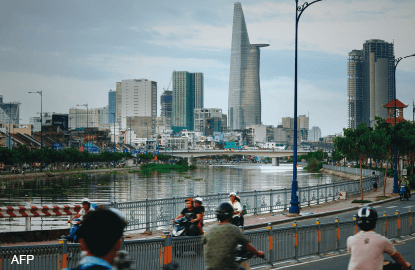
This article first appeared in The Edge Malaysia Weekly, on October 26 - November 1, 2015.
While export growth in Malaysia has been far from exciting in the past few years and the domestic economy has had to rely on consumer spending and private investment, it is a different story in Asean neighbour Vietnam.
The Indochina country is enjoying accelerated growth while much of the rest of Asia-Pacific is experiencing a slowdown and expecting challenging times ahead.
Vietnam’s gross domestic product grew 6% last year, up from 5.4% in 2013, and economic issues such as a volatile currency and high inflation seem to be past history for the country.
In contrast, Thailand, Indonesia and the Philippines recorded slower year-on-year growth in 2014.
Economists point out that the stronger Vietnamese economic growth last year was led by exports.
“Vietnam’s main exports are textiles, garments and apparel, which have benefited from lower wages compared with China,” says RHB Research chief economist Lim Chee Sing. “While exports from other countries in the region have been slowing, Vietnam’s exports have been growing at a double-digit rate.”
Vietnam’s strong economic growth stands out among its neighbours. GDP growth continued to accelerate at a faster pace of 6.28% in the first half of the year (1H2015), compared with 5.18% for the same period last year and 4.9% in 2013.
In Indonesia, economic growth slowed to 4.7% in 1H2015, compared with 5.1% last year and 5.9% in 2013. The Philippines did not fare any better, with growth in 1H2015 slowing to 5.3%, compared with 6.2% last year and 7.7% in 2013.
The dynamism of the Vietnamese economy is not due to chance but is the culmination of years of reforms of the state-owned enterprises (SOEs), trade agreements the country entered into as well as the devaluation of the dong, says Lim.
“Vietnam has signed various trade agreements, which has made its economy more open to international trade and foreign investment. Exports and investment growth are the main drivers of the economy,” he adds.
Trade liberalisation started with the normalisation of economic relations with the US in 2000, followed by Vietnam’s ascension to the World Trade Organization in 2007.
Vietnam is also one of the signatory countries of the Trans-Pacific Partnership Agreement (TPPA). The agreement, if ratified by the 12 participating countries including the US, Canada, Mexico, Peru, Australia and Malaysia, would give Vietnamese producers better access to these markets.
Vietnam is expected to become the biggest beneficiary of the TPPA, with its merchandise products more competitively priced in the large markets of North America, Japan and Australia than those from China.
“This is a dynamic change in the regional economy. While China is not part of the TPPA, it is spearheading the Regional Comprehensive Economic Partnership, which will see the creation of a bigger market than that of the TPPA,” says Lim.
Vietnam’s exports are already highly competitive because of the government’s policy of devaluing the dong, increasing the currency’s trading band by 1% every year. This year alone, in response to slumping Asian currencies, Vietnam has devalued the dong three times.
Meanwhile, rising wages in China have contributed to the strong foreign direct investment flowing into Vietnam over the last two years (see graphic). The average wage in the textile industry in the country is about US$250 per month, compared with US$650 in China, says a businessman with operations in Vietnam.
However, not everything is rosy.
An opaque regulatory environment, protection of the SOEs by the government and monetary policy are among the areas that the Vietnamese government has to improve on, says the businessman.
“Sometimes, what we understand differs from what the authorities understand when it comes to the regulations. There is very little transparency and this has caused much difficulty for foreign businesses to enter Vietnam,” he says.
Protection of the SOEs from foreign competition is another concern. The growth of the economy was curbed by SOEs saddled with bad debts between 2008 and 2012, and the central bank had to step in to bail out some of the banks.
RHB Research’s Lim says protecting the SOEs caused a drag on the economy as foreign and private investors were discouraged from investing and moving up the value chain to improve their competitiveness.
However, the government has since further liberalised the economy by allowing foreign investors to form joint ventures with the SOEs.
Reform of the banking sector too is underway, albeit slowly.
The benefits from being in a trade partnership such as the TPPA also do not come automatically, says Lim. Producers in the partner countries have to continue to innovate to become more productive and efficient to gain market share.
That is something that other countries in Asean, including Malaysia, should take note of to ensure their products and services are competitive in the international arena.

Save by subscribing to us for your print and/or digital copy.
P/S: The Edge is also available on Apple's AppStore and Androids' Google Play.